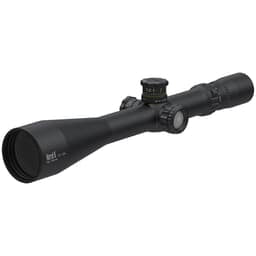

March X "High Master" 10-60x56mm SFP MTR-4 Reticle riflescope features a versatile magnification range, allowing users to adapt from 10x to an impressive 60x with ease. The 6-level illumination system enhances visibility across various lighting conditions, ensuring precise targeting in low-light scenarios. Built with Super ED glass, this scope provides edge-to-edge clarity and natural color reproduction. The tactical-style illuminated reticle positioned in the second focal plane offers accurate aiming, while the exposed turrets enable precise 1/8 MOA adjustments for windage and elevation.
Engineered for competitive shooting and varmint hunting, the March X is designed with a middle focus wheel for quick adjustments. Its durable construction is both waterproof and shockproof, making it suitable for rugged outdoor conditions. Weighing just 33.86oz, this scope is relatively lightweight for its performance capabilities, allowing for easy transport and mounting on various platforms.
Features:
- VERSATILE MAGNIFICATION for adapting to different shooting ranges from 10x to 60x.
- ENHANCED ILLUMINATION with a 6-level system for clear visibility in various lighting conditions.
- EDGE-TO-EDGE CLARITY using Super ED glass for natural color and high-resolution images.
- PRECISE ADJUSTMENTS with 1/8 MOA exposed turrets for accurate windage and elevation control.
- MIDDLE FOCUS WHEEL for quick adjustments, enhancing user convenience during dynamic shooting scenarios.
- DURABLE CONSTRUCTION that is waterproof and shockproof, ensuring reliability in outdoor environments.
- SECOND FOCAL PLANE RETICLE maintains reticle size while zooming for consistent aiming accuracy.
- LIGHTWEIGHT DESIGN at just 33.86oz, making it easy to transport and mount on various firearms.
Technical Specifications Table
| Feature | Details |
|---|---|
| Magnification | 10x - 60x |
| Objective Lens Diameter | 56mm |
| Reticle Position | Second Focal Plane |
| Eye Relief | Low: 3.15-4.21in, High: 3.62-4.02in |
| Exit Pupil | 0.94mm |
| Field of View | 10.2 - 1.7ft at 100yds |
| Weight | 33.86oz |
| Tube Diameter | 34mm |
What's in the Box?
- March X "High Master" 10-60x56mm SFP Riflescope
- Lens covers
- Padded case
- User manual
Customer Reviews
“This scope is a game-changer for my long-range shooting. The clarity is unmatched.”
“The illumination feature really helps during low-light conditions. Highly recommend for serious shooters.”
“Lightweight and durable. Perfect for my varmint hunting trips.”
FAQ
What is the maximum effective range of the March X scope? The maximum effective range is typically around 1,000 yards, depending on the caliber used and the conditions. Its high magnification allows for precise targeting at long ranges.
Is the March X riflescope suitable for beginners? Yes, the user-friendly adjustments and clear optics make it a great choice for beginners as well as experienced shooters. The scope’s lightweight design also aids in easy handling.
How does this scope perform in low-light conditions? With its 6-level illumination and high-refractive glass, the March X excels in low-light conditions. The illumination helps to highlight the reticle, ensuring accurate aiming even at dawn or dusk.
Can the March X be mounted on different types of firearms? Yes, the 34mm tube diameter is compatible with a variety of mounting systems, making it versatile for different firearms, including ARs and bolt-action rifles.
What maintenance does this scope require? Regular cleaning of the lenses with a soft cloth is recommended. Ensure the scope is stored in a dry, cool place to maintain its performance and longevity.
Similar Models
Looking for more optics? Explore our full lineup of March scopes, including models like March 4-16x52 for versatility and March 5-40x56 for extreme long-range performance. Each model is designed to meet the needs of discerning shooters seeking precision and reliability.
``` This HTML output follows the requested format, providing detailed and practical information about the March X "High Master" riflescope while adhering to SEO best practices.You May Also Like
Here’s some of our most similar products people are buying. Click to discover trending style.









